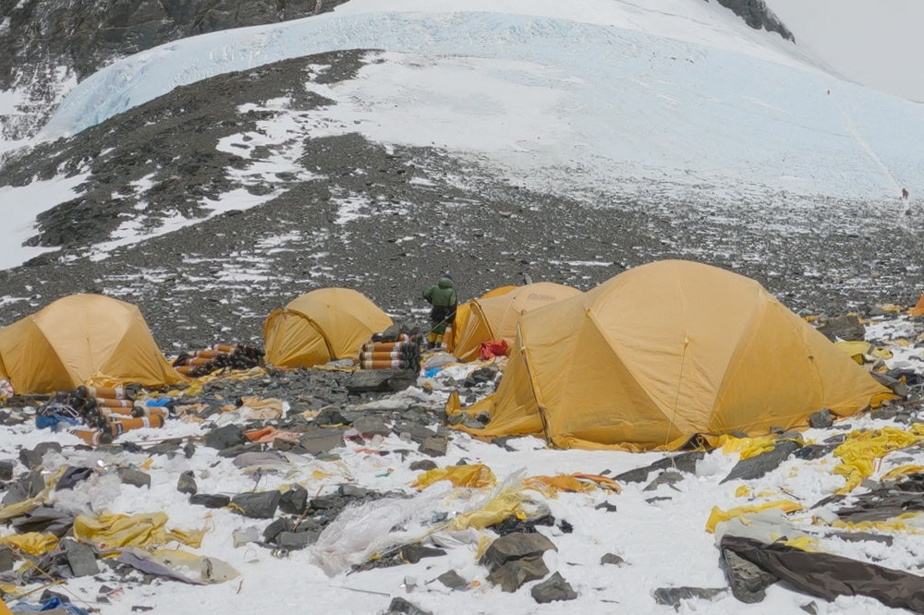(Kathmandu) Climbing Everest is always a perilous adventure, but at the end of the season, which is among the deadliest, local professionals blame extreme weather conditions, breaches of safety, impatience and the inexperience of some foreign mountaineers.
As high mountain rescuers pack up their gear and the sea of camps at the foot of Everest recedes, Nepalese experts say some of this year’s 17 deaths could have been avoided.
“This season has been very bad overall,” said Mingma Gyalje Sherpa of Imagine Nepal Trek and Expedition, “mainly due to extremely cold weather. […]but there was also negligence”.
Five mountaineers, on average each year, die on the steep and frozen sides of the highest mountain in the world, culminating at 8849 meters.
One of the most disastrous records is reached on Everest this year with twelve dead and five missing.
Ten of them were foreigners, the highest number ever recorded, along with seven Nepalese.
The mountaineering industry in the Himalayas is based on the experience of the Sherpas, an ethnic group of Nepalese mountaineers, who pay a heavy price to accompany hundreds of mountaineers each year.
In 2014, 16 Nepalese guides were swept away by an avalanche that occurred after the season.
In April 2015, at least 18 mountaineers were killed in another flow triggered by a violent earthquake, which killed nearly 9,000 people in total in the country.
“Minus 40°C”
Nepalese authorities have granted a record 478 climbing permits to foreign climbers and 600 mountaineers, including Nepalese guides, have reached the summit, according to the Ministry of Tourism.
Some believe that foreigners are often ill-prepared for this major physical and psychological test that is the ascent of Everest.
Others think that the number of climbers on the mountain where the traffic becomes too dense should be reduced or stricter safety rules adopted.
And almost everyone agrees that, in memory, the mountain had never experienced such cold temperatures in this season.
“It should already be hot, around -28° Celsius, but this year it was even -40°”, underlines Mingma Gyalje Sherpa.
If climate change causes extreme temperature fluctuations, scientists recommend not to draw hasty conclusions about particular events, without prior studies.
This season, the Mingma Gyalje Sherpa team, consisting of Dawa Tseri, Pemba Tenzing and Lakpa Rita Sherpa, was tasked with leading the way to the summit of Everest.
They didn’t come back. The trio were crossing the dangerous Khumbu Icefall to deliver supplies to Camp 1, when a block of ice broke off and buried them.
Over the course of the season, deaths and missing at altitude have accumulated.
According to Mingma Gyalje Sherpa, many Nepalese guides and porters suffered from frostbite due to freezing temperatures and high winds early in the season.
“This means that Camp 4 was not sufficiently prepared and that all the equipment did not reach it […]but faced with the impatience of the customers, the climb began,” he explains.
“Some victims could have been avoided if all the material had been sent,” he said.
Oxygen and safety
The rapid expansion of the mountaineering industry has created fierce competition between expedition organizations and raised concerns that some are neglecting safety standards.
The majority of deaths could have been avoided “with mandatory safety standards”, agrees Lukas Furtenbach, boss of the Austrian agency Furtenbach Adventures.
“These accidents all have a similar context,” he continues. In addition, the theft of oxygen cylinders “in several teams, including ours, reveals one of the main problems of the season […] oxygen logistics and safety standards,” he laments.
Many foreigners ended up giving up the climb, despite the cost of $11,000 for the permit and at least $30,000 more for the expedition.
“Confidence has been shaken,” says Dawa Steven Sherpa of Asian Trekking, “when people get sick, others are rescued, bodies come down, even the most physically prepared climber wonders. “.
By accompanying a Chinese mountaineer, the Nepalese guide Gelje Sherpa decided to give up the summit of Everest, to save a Malaysian in distress, encountered at more than 8000 meters, in the “death zone”, where oxygen is scarce .
“It’s been a tough year psychologically and physically for the Sherpas,” adds Dawa Steven Sherpa, “some left, many were injured, those who stayed on the mountain were overworked. Everyone was exhausted.”
